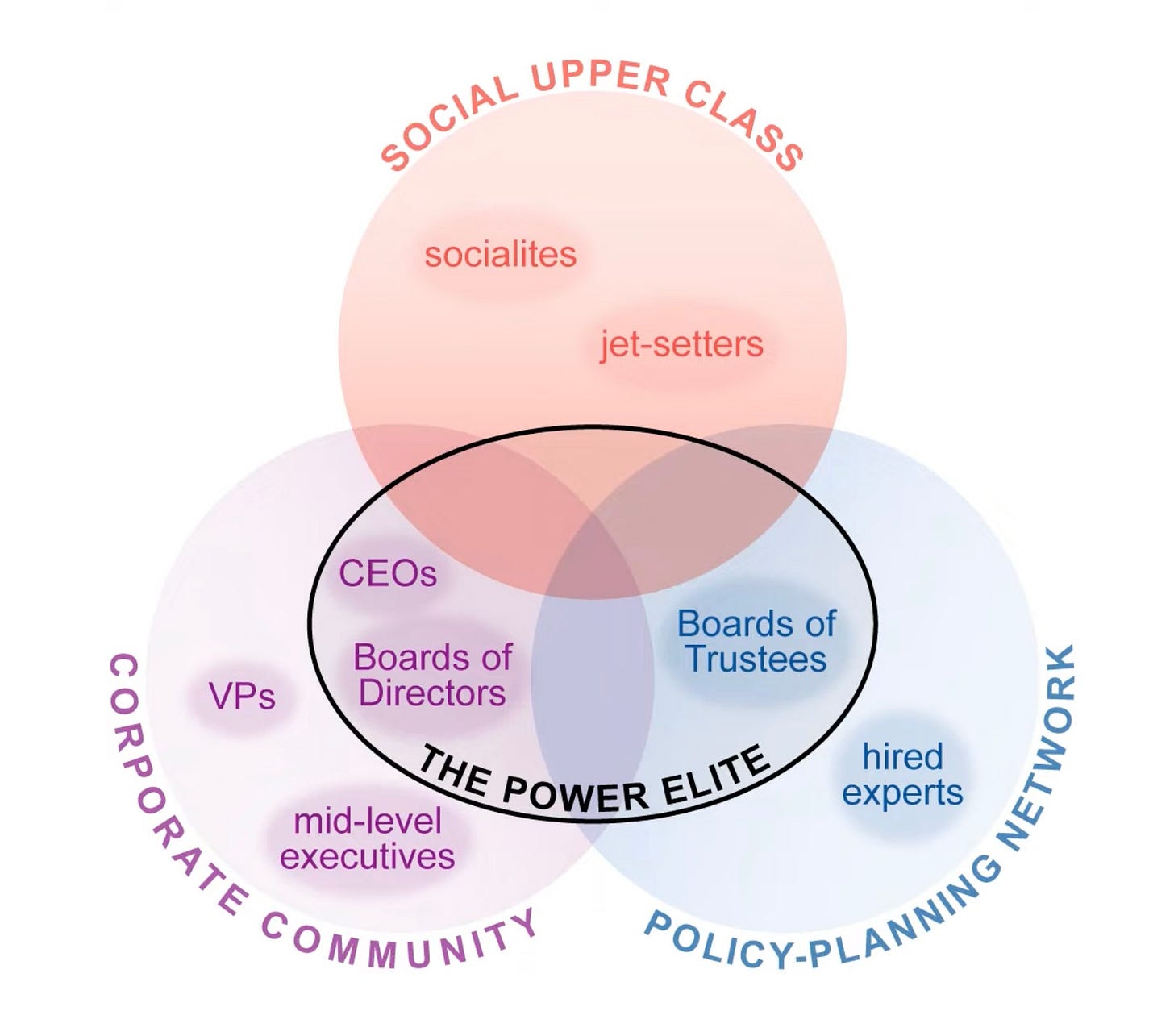You've probably never heard of G. William Domhoff, but he is quite a remarkable man. Born in 1936, he is still actively working and lecturing on a topic he has been researching for over half a century: who controls our society, and how do they do it?
Domhoff's magnum opus is a slim volume entitled Who Rules America. He has updated it every few years since its initial publication in 1967, and the eighth edition was released in 2023. While the details and specific facts and figures have evolved over time, Domhoff's fundamental observations have remained consistent for the last six decades.
1. A small “power elite” controls the organizations that run our society.
According to Domhoff’s research into power structures, all major institutions – governmental, academic, business, and non-profit – are run by the same power elite. This group comprises an “interlocking directorate” of individuals who hold position of authority in the social upper class, the corporate community, and the public policy-planning network.
This power elite is dominated by, but not exclusively composed of, the wealthiest stratum of society. While some members of the upper class are “functionless genteel,” and some members of the middle-class hold influential roles within dominant institutions, the true reins of power are held by those select few at the center of the Venn diagram where leadership of the public, private, and social sectors intersect.

2. To the power elite, social networking is key.
Have you ever heard a celebrity mention calling another celebrity for the first time, and wondered how they got that phone number? Domhoff quotes an earlier researcher, E. Digby Baltzell, who explains that “A social class is the largest group of people whose members have intimate access to one another. A class is composed of families and social cliques.”
In practical terms, this means that members of the upper class all know each other because they live in the most luxurious suburbs, send their children to the most exclusive prep schools, vacation at the most expensive destinations, and are invited to sit on the boards of the most influential organizations. They grow up together, work together, and socialize together.
Because of this, they share a circle of trust, within which information - such as personal phone numbers - can be shared freely, because of the understanding that it will not be released to the outside world.
With that said, Domhoff is critical of conspiratorial thinking. He views so-called secret organizations and social gatherings such as Bohemian Grove as evidence of social cohesion within the upper class, but not as evidence of grandiose conspiracies. He often uses the phrase, “social cohesion contributes to policy cohesion,” meaning that the more people get to know each other, the more they agree on what should be done, without any need for covert planning.
In Domhoff’s opinion, while confidential plans and conversations are a normal occurrence within the halls of power, it is a mistake “to take these everyday machinations as evidence for some grand conspiracy at the societal and historical levels.” Instead, he views the power elite as too focused on short-term gains to waste time and resources trying to secretly establish a one-world government or other major, long-term paradigm shift.
3. Molding public opinion is a form of power.
Although he does not consider it a conspiracy, Domhoff writes extensively about “opinion shaping.” On this subject, he quotes sociologist Richard Rovere, who wrote that the ruling elite “has very nearly unchallenged power in deciding what is and is not respectable opinion in this country.”

Domhoff explains that opinion shaping is accomplished through all the major institutions of our society: government, academia, media, and industry. Since they are all controlled by the upper class, they all act in concert to support the upper class's interests.
He cites Morris Janowitz, who observed, “the influence of mass media, supported by networks of interpersonal contacts among opinion leaders, lies not in dramatic conversion in public opinion, but rather in setting the limits within which public debate on controversial issues takes place.” Sometimes, this is referred to as the Overton window, but the concept is the same - the ideas that are considered to be within reason are dictated by boundaries set by those in positions of authority.
4. The upper class recruits and assimilates useful members of the lower classes.
As Domhoff states, “Most of the non-upper-class leaders are selected and trained by members of the upper class. The advancement of these non-upper- class leaders is dependent upon their attaining goals that are shared by members of the upper class.”
Just as it is very difficult (perhaps impossible) for a candidate opposed by the power elite to attain high office, it is rare for an entrepreneur to become successful without upper-class endorsement or support. The reverse is equally true: when you see a formerly- favored politician, CEO, or celebrity suddenly fall from grace, you are witnessing what happens to those whose wealth and power is dependent on their service to the power elite.
5. The power elite is mostly, but not entirely, monolithic.
Many sociologists argue that, unlike traditional societies where a hereditary elite shares a common set of values, the pluralistic nature of America's upper class has produced a set of unseen checks and balances. Domhoff disagrees.
Regional, sectarian, political, and philosophical differences are, in Domhoff's estimation, not just for show, but they are also not very important. Disparate members of the upper class have much more in common with each other than with their lower-class neighbors or co-religionists.
Thus, although prejudices, disagreements, and competitive business relationships exist between various factions of the power elite, this does not prevent them from acting in their shared best interests. This is why, despite public squabbling over culture and politics, wealth and power continues to be increasingly concentrated within the tiniest segment at the top of the social pyramid.
Further Reading
Domhoff is a brilliant scholar and an engaging writer. His prior editions of Who Rules America mostly steered clear of political commentary. However, the most recent edition is more politicized. Readers who wish to avoid being distracted by discussion of Donald Trump, January 6th, and other controversial topics might prefer to pick up a used copy of one of the earlier, more politically-neutral, editions of his book.
Whichever version you decide to pick up, Domhoff’s impeccable research and enormous knowledge make Who Rules America required reading for anyone who wants a clearer understanding of the power structures that control our lives.






I grow some food.
Surf with friends.
Learn new skills.
And guide my children.
These people have nothing to do with me.
Looking at that venn diagram all I can see is Lauren Sanchez , so as I suspected she actually running the show